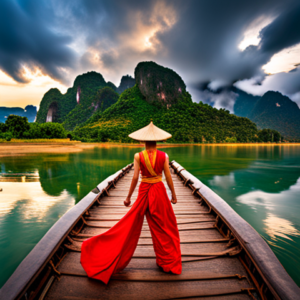In the heart of Southeast Asia, amidst the gentle ripples of the Mekong River, lies an ancient tradition that continues to unite communities and celebrate the vibrant culture of Laos. The spectacle of Laos’ traditional boat races is more than just a display of agility and skill on the water; it is a deeply entrenched part of the Lao heritage, drawing roots from centuries past.
Historical Significance
The boat races, known locally as ‘boun xuang heua’, date back to the 14th century when King Fa Ngum founded the Lan Xang Kingdom, which is now modern-day Laos. It was during these times that the races first began as a means to train sailors for warfare and to honor the gods and the mighty Mekong River, which is the lifeblood of the nation. Today, the races are vibrant celebrations that mark the end of the annual Buddhist Lent.
The races hold immense cultural significance, acting as a symbol of unity among the various ethnic groups that call Laos their home. Teams from all over the country come together, not just to compete but to share in the pride of their heritage, showcasing their strength and solidarity through this monumental event.
Event Details
Laos’ traditional boat races are a series of spirited events that take place in several locations along the Mekong River. The races typically span from September to October, coinciding with the end of Buddhist Lent, and vary in size, from small local races to grand national events. Each boat race is accompanied by lively festivities, including traditional music and dance, as well as vibrant markets showcasing local crafts and delicacies.
Spectators are drawn to the riverbanks to witness this magnificent display of sporting prowess. The races feature long, sleek boats powered by teams of up to eighty paddlers, with a drummer at the helm to maintain the rhythm. The boats surge through the water, vying for the finish line and the honor of their communities.
Boat Designs and Symbolism
The boats themselves are cultural relics, each design steeped in tradition and meaning. Crafted from hardwoods such as teak and rosewood, the boats can stretch up to twenty meters in length and are often decorated with colorful motifs and carvings. They are believed to embody the ancient Naga serpents that are prevalent in Lao mythology, offering protection and strength to those who travel upon the water.
The number of paddlers and the specific designs of the boats can vary from region to region, reflecting the distinct cultural identities of the Lao people. They stand as testaments to the customs and beliefs that have been passed down through generations, with the races serving to both preserve and promote this diversity.
Participant Experience
For those who partake in the races, it is a year-round commitment that goes beyond mere competition. Teams, or ‘khaen’, dedicate themselves to rigorous training schedules, often beginning as soon as the previous year’s race concludes. The experience is not merely physical; it is a spiritual and mental undertaking that instills a sense of discipline and honor in participants.
“Sometimes we barely see sunlight for months leading up to the race,” shares a local boat racer. “But the sense of camaraderie and purpose that comes with it is something that binds us together and keeps the tradition alive.”
Audience Engagement
The races are an immersive experience for spectators, providing an insight into the heart of Laotian culture. Visitors can expect to indulge in a sensorial feast, sampling local cuisine and traditional spirits, while the sounds of gongs and flutes fill the air. The energy is palpable as crowds cheer on their favorite teams, adding to the fervor and passion that encapsulate the festivities.
For many, attending a boat race is not just a one-time event but a lifetime highlight. The opportunity to witness this timeless tradition and engage with the warm hospitality of the Lao people leaves an indelible mark on those who experience it.
Impact on Tourism
The traditional boat races contribute significantly to the local economy, drawing in tourists from around the globe. The influx of visitors not only provides a financial boost for the communities but also serves as a platform for cultural exchange. Travelers have the opportunity to engage with the local population, learn about Lao customs, and support the preservation of this centuries-old tradition.
Furthermore, the races play a pivotal role in the promotion of Laos as a cultural travel destination, attracting those who seek to explore and understand the country’s unique heritage. It is through such events that the essence of Laos, with its rich history and warm community spirit, is brought to the forefront and shared with the world.
Conclusion
Laos’ traditional boat races represent the very best of the country’s cultural fabric. They embody resilience, unity, and the endurance of time, continuing to be a significant part of the national identity. For the Laotian people, the races evoke a profound sense of pride and connection to their past, while visitors are treated to an unforgettable glimpse of Lao life and tradition.
In our increasingly interconnected world, where cultures often intermingle, it is the maintenance of such unique and authentic traditions that sets countries like Laos apart. The commitment and enthusiasm that surround the boat races are a testament to the unwavering dedication of the Lao people to honor their historical legacies, ensuring they are celebrated for generations to come.
For those eager to explore the lesser-known corners of the globe and immerse themselves in cultural heritage, the vibrant and time-honored boat races of Laos are not to be missed. They offer a window into a world of myth and tradition, reinforcing the value of heritage in uniting communities and enriching the human experience. It is through such celebrations that we truly appreciate the diverse tapestry of human culture, and the timeless appeal of events that bring both locals and global citizens together.
